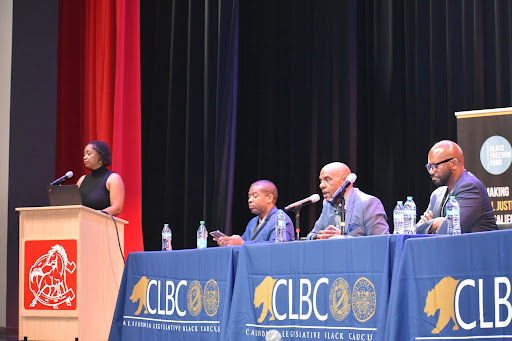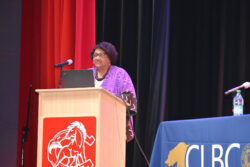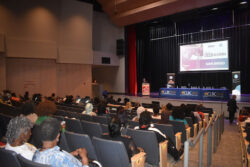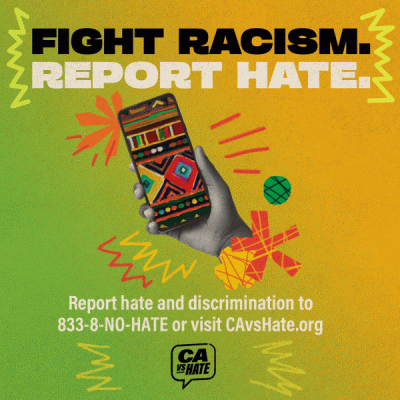
By Macy Meinhardt, Voice & Viewpoint Staff Writer
“We are at the brink of changing history in the state of California, where California goes, the nation follows,” said Assemblymember Mike Gibson (D-65) at San Diego’s State of Black California event.
Members of the California Legislative Black Caucus came to Crawford High School last Saturday as one of their first stops across California cities to educate Black Californians on the current policy agenda towards achieving reparations.
Apology, acknowledgement, atonement. These three are the leading objectives at the heart of the California Legislative Black Caucus (CLBC) reparations agenda. The series of panels featured a presentation of Black San Diego demographics, policy efforts, reparation eligibility, and a Q&A session with CLBC members Senator Steve Bradford, Assemblymember Dr. Corey Jackson (D-60), and Assemblymember Mike Gibson (D-41) .
“The call for reparations is not merely an acknowledgement of past wrongs. It is a moral imperative. A recognition of the debt owed to Black Californians who have suffered and persevered in the face of systemic oppression,” said Assemblymember Dr. Akilah (D-79) who hosted the June 15 event.
The Misconception of Black California
The debt is in accordance with deep rooted inequalities in housing, healthcare, education, and economic opportunity that lingers from the historical enslavement of Black Californians. In January, the caucus announced a series of bills that aims to comprehensively dismantle the legacy of slavery and systemic racism.
Members of the CLBC caucus stressed that despite public perception, California was never a free state. The study produced by the Reparations Task Force documents the expansion of slavery into the West, and how enslavement practices were perpetuated regardless of California’s status as a “free-state” and loosely enforced anti-slavery laws.
“This is not the greatest nation in the world just because of happenstance. It was because of over 300 years of free labor, by people who look like me, who suffered and toil and lost their lives in order to build this nation,” said Senator Bradford (D-35).
In approaching the first step towards acknowledgment, Assemblymember Dr. Weber put forward a bill titled ACR 135— “Acknowledgment of Gross Human Rights Viola tions and Crimes Against Humanity on African Slaves and their Descendants”

As one of the 14 bills put together in the caucasus reparations package, this measure would “acknowledge the harms and atrocities committed by representatives of the State of California who promoted, facilitated, enforced, and permitted the institution of chattel slavery and the legacy of ongoing badges and incidents of slavery that form the systemic structures of discrimination.”
Other bills featured in the package address criminal justice reform, civil rights, education, health, and business.
“The nation is waiting for us to lead. And as California always does, we will lead in addressing a delayed justice called Reparations,” said Secretary of State Dr. Shirley Weber.
Dialogue among the members of the caucus on stage also extended to the audience during the Q&A portion of the event.
When will reparations begin?
One of the findings in the State of Black California report shows that it will take approximately 248 years for persistent gaps for Black residents to close. But in terms of this first bill package “It is the urgency of now to get these 14 bills passed,” Senator Bradford said, saying he hopes the bills go through both houses and to the governor’s desk within the year.
In terms of the additional expansion of more reparation bill packages, it could take years if not decades, caucus members say.
Who will receive reparations?

Caucus members say that anyone who is a descendant of chattel slavery in the State of California or arrived in the State of California prior to the early 1900’s are eligible for consideration of reparations.
State of Black San Diego
Members of the audience also got to learn about the state of Black San Diego By Dr. Manuel Pastor from the USC Equity Research Institute. Key stats that highlight the historical disenfranchisement of San Diegans include the Black unemployment rate—which since the 1990’s has remained 2x higher than the white unemployment rate. Disparities within higher education, rent burden, environmental exposure, and median income were also presented.
Leaders from the San Diego community that were in attendance were District 4 Supervisor Monica Montgomery Steppe, District 4 Councilmember Henry Foster, Lemon Grove Mayor Racquel Vasquez, and San Diego Unified Superintendent Dr. Lamont Jackson.
“ Today is the start of many necessary conversations regarding reparations for the current stare. I think it’s a start to the package here in San Diego and bringing more attention and bringing the importance to the forefront,” said Councilmember Foster.
How far is the City of San Diego from implementing reparations for Black San Diegans?
“I think the City of San Diego itself has a very long way to go. I think if you just look at our budget discussion that we currently had, I think it really shows the sentiment of leadership in the city of San Diego,” said Foster, referring to the upward battle councilmembers and community members endured to reverse the harsh cuts to equity programs originally proposed by Mayor Todd Gloria.
The report in which the recent bill package stemmed from, is over 1,000 pages long. While lengthy, caucus members expressed multiple times the importance of Black Californians to review the study to foster a comprehensive understanding of their history and the pathway to repair. For a brief overview visit the executive summary: https://oag.ca.gov//exec-summary-ca-reparations.pdf
For the full report visit: https://oag.ca.gov/full-ca-reparations.pdf



